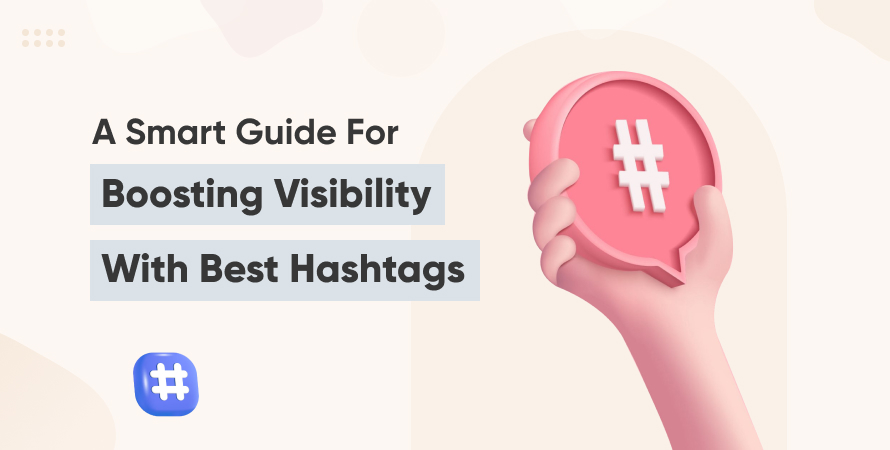A Smart Guide for Boosting Visibility With Best Hashtags



In a world where social media algorithms shift faster than trends, hashtags remain a powerful tool for increasing visibility, reach, and engagement—especially on platforms like Instagram. But simply tagging a post isn’t enough anymore. Agencies must adopt a smart, strategic approach to help their clients stand out in the crowd.
At White Label SEO Providers, we understand that most agencies struggle with helping clients leverage hashtags correctly. This blog is designed to give you, a fellow agency, a comprehensive, evidence-backed guide to using hashtags effectively—so your clients can achieve real results without the fluff.
Whether you’re working with small businesses or scaling enterprise brands, mastering the art and science of hashtags will set your services apart. Let’s break it down.
The Psychology Behind Hashtags
Before you get tactical, you need to understand why hashtags work in the first place. Originally introduced on Twitter in 2007, hashtags have evolved into powerful tools that help users discover content, join conversations, and connect with communities.
Hashtags tap into what we call discovery-based intent. When users search or follow a hashtag, they’re actively looking for relevant content—unlike passive scrolling. This means hashtagged content shows up in feeds where users are more receptive and likely to engage.
This behavior is critical for agencies managing brands trying to expand their audience. A single post with the right tag can reach thousands beyond a brand’s follower list. That’s the potential you’re unlocking when you choose the best hashtags for a client’s campaign.
And remember: people don’t just use hashtags to browse—they use them to belong. Community hashtags, industry tags, and even branded tags make your clients’ posts feel connected and relevant.
Hashtags and the Algorithm: How They Work
To maximize visibility, you need to understand how hashtags interact with social media algorithms. While each platform uses them a little differently, they all rely on hashtags to categorize content.
Instagram uses hashtags to index posts. When a user searches or follows a hashtag like #interiordesign or #fitnessjourney, Instagram surfaces relevant posts. The platform evaluates relevance, engagement, and recency when deciding which posts to show. Using the top Instagram hashtags blindly won’t work if they’re not relevant to the content.
Twitter/X
Hashtags are still used for real-time discovery and trending topics. Tweets with hashtags get higher engagement, but the key is using contextually appropriate tags—especially during live events or announcements.
Hashtags help with content discovery, especially for thought leadership posts. LinkedIn allows users to follow hashtags like #DigitalMarketing or #LeadershipTips to stay updated.
TikTok & YouTube
Both platforms rely heavily on hashtags for searchability and algorithmic recommendations. TikTok, in particular, boosts trending content when it includes trending hashtags on Instagram and TikTok ecosystems alike.
Myth to Bust:
Using more hashtags doesn’t mean better reach. In fact, overloading a post with irrelevant or generic hashtags can reduce visibility, or worse, result in a shadowban. What matters most is relevance and intent.
Choosing the Right Hashtags: A Keyword Strategy for Social
Just like SEO, hashtags function as keywords for social media. And like SEO, they require research.
How to Research Hashtags:
- Use tools like Hashtagify, Flick, or RiteTag to analyze performance metrics.
- Study competitors in your niche and note which hashtags generate the most engagement.
- Segment hashtags into categories:
- Branded hashtags: Unique to your client (e.g., #MyBrandStyle)
- Niche hashtags: Industry-specific and less competitive (e.g., #VeganFitness)
- Community hashtags: Group identity or shared interest (e.g., #MomsWhoCode)
- Trending hashtags on Instagram: Popular, timely tags tied to current events or viral challenges.
Encourage your clients to maintain a hashtag bank categorized by content type. This makes it easier to swap hashtags based on the goal of the post.
Internal tip: Learn how to further enhance social campaigns with white label social media automation tools to streamline hashtag deployment across platforms.
How Many Hashtags Should You Use?
This is one of the most common questions we get from agencies, and the answer is: it depends on the platform.
Instagram:
- The app allows up to 30 hashtags, but studies show 3–5 highly relevant hashtags often perform better.
- Focus on combining popular hashtags on Instagram with niche ones to balance reach and specificity.
Twitter/X:
- One to two hashtags per tweet is ideal. Over-tagging decreases readability and engagement.
LinkedIn:
- Three to five hashtags per post, aligned with professional intent and audience.
TikTok:
- Use up to five hashtags that mix best hashtags for Instagram (cross-platform consistency) and trending ones on TikTok.
Best Practices:
- Avoid hashtag stuffing.
- Use a mix of branded, trending, and descriptive hashtags.
- Track performance and refine your strategy with analytics tools.
Using the best Instagram hashtags is about choosing what aligns with content, not just what’s popular. Too many irrelevant hashtags can confuse the algorithm and push your post out of the discovery zone.
Structuring Hashtags for Maximum Visibility
Now that you know which hashtags to choose and how many to use, let’s talk about placement and structure.
Where to Place Hashtags:
- Instagram: In the caption or the first comment. Both methods work, but keeping them in the caption makes them instantly discoverable.
- Twitter/LinkedIn: Embed naturally within the sentence or add them at the end.
- TikTok/YouTube: Add hashtags in the description, ensuring they’re visible and readable.
Tips to Optimize:
- Use line breaks to make captions clean and readable.
- Group related hashtags together to give structure and logic.
- Avoid repetitive or banned hashtags, which can lead to content suppression.
Encourage your clients to refresh their hashtag bank regularly to avoid saturation. What worked three months ago may no longer yield results.
If your agency handles full-scale campaigns, explore our social media management services to deliver hashtag-ready, optimized content calendars with real ROI.
Hashtag Trends: Riding the Wave Without Crashing
Hashtags can explode in popularity overnight, but leveraging trending IG hashtags effectively requires more than just jumping on the bandwagon. For agencies helping clients grow, the challenge is to strike the balance between trend relevance and brand alignment.
How to Spot Trends:
- Monitor platforms daily—especially TikTok and Instagram.
- Use tools like Trendsmap, Trendinalia, or Flick to identify fast-rising tags.
- Follow industry influencers and hashtags for early indicators of traction.
When to Use Trending Hashtags Instagram Campaigns:
Only incorporate trending hashtags Instagram users are genuinely engaging with and that relate to your client’s content. Hijacking a trend that has no relevance may lead to visibility but won’t drive engagement—or worse, it can damage brand trust.
Examples:
- A wellness brand can use a trending hashtag like #SelfCareSunday if it aligns with its voice and content theme.
- A tech brand jumping into a food trend? That might confuse followers.
For niche industries, such as HVAC, trend-jacking requires even more nuance. Our blog on how agencies can dominate HVAC social media marketing shares examples of how specific industries can tap into broad trends with authenticity.
Advanced Tips: Hashtags for Different Goals
Just as every social post serves a unique goal—awareness, engagement, traffic—hashtags should align with that intent. Agencies that guide clients to select hashtags based on purpose will see more targeted results.
Discovery:
Use descriptive and widely searched tags to help new users find your content. These include popular hashtags for Instagram like #FitnessGoals or #DigitalMarketingTips, depending on your niche.
Engagement:
Use community-driven or conversational hashtags. These are less competitive but highly effective for boosting likes, comments, and shares.
Campaign Tracking:
Custom, branded hashtags like #GrowWithBrandX let you track campaign performance and encourage UGC (user-generated content). They’re great for contests and product launches.
Event Promotion:
Combine event-specific tags with broader popular Instagram hashtags to enhance visibility before, during, and after events.
We covered more engagement techniques in our guide on boosting white label social media conversions—a must-read if you’re managing high-volume campaigns.
Common Mistakes to Avoid
Agencies often fall into common traps when managing hashtags. Here are the key pitfalls to avoid if you want to deliver meaningful results to clients:
- Using too many generic hashtags like #love or #happy. These may be the top hashtags on Instagram, but they’re oversaturated and ineffective without relevance.
- Failing to update hashtags. Trends change, and what worked last quarter might now be irrelevant.
- Copy-pasting the same hashtag set for every post. Each piece of content should have a custom-tailored group of hashtags.
- Neglecting analysis. Using the best hashtag means nothing if you don’t measure its performance over time.
Instead, build flexible hashtag strategies that evolve based on results. Our blog on 30 social media statistics you can’t miss for 2025 is a great resource for staying up to date with how platforms and user behaviors are shifting.
How to Analyze Hashtag Performance
To truly use Instagram hashtag strategies effectively, you need to track how well they’re working.
What to Measure:
- Reach and Impressions: Are new users discovering your posts via hashtags?
- Engagement: Are specific hashtags driving likes, shares, and comments?
- Saves and Clicks: Especially on Instagram, these are key conversion indicators.
- Follower Growth: Which tags contribute to growing your client’s audience?
Tools to Use:
- Instagram Insights (for Business accounts)
- Flick, Keyhole, or Later
- Native platform analytics from TikTok, LinkedIn, etc.
Create a monthly report that breaks down performance per hashtag group. Show your clients how well your chosen popular hashtags are working—and don’t be afraid to test new ones each month.
If you’re an agency looking for scalable reporting and management support, our white label services are built exactly for that.
Conclusion
Hashtags have become essential tools in driving visibility, engagement, and growth on social media—but only when used with purpose. For agencies managing multiple clients, a strategic approach to hashtags can differentiate your services and deliver measurable results. Simply using trending or popular tags isn’t enough; success lies in selecting hashtags that align with your client’s content, goals, and audience.
This guide has covered everything from understanding the psychology behind hashtags to analyzing their performance across platforms like Instagram, Twitter, LinkedIn, and TikTok. Whether you’re leveraging top hashtags on Instagram for reach or crafting niche tags for community building, every hashtag should serve a clear function. Avoid the temptation to overload posts with irrelevant tags and instead focus on quality, relevance, and continual optimization.
At White Label SEO Providers, we empower agencies with scalable, results-driven social media solutions. Our social media management services are designed to help you implement strategies like these with ease and precision.
Frequently Asked Questions (FAQs)
While Instagram allows up to 30 hashtags, using 3–5 highly relevant and targeted hashtags tends to yield the best engagement and reach.
Yes. Branded hashtags help track campaigns, encourage user-generated content, and strengthen brand identity across social platforms.
Trending hashtags are time-sensitive and tied to current events, while popular hashtags consistently perform well but are often very competitive.
Review and update your client’s hashtag lists monthly. Trends shift, and analytics reveal which hashtags are driving the most results over time.